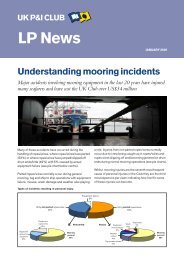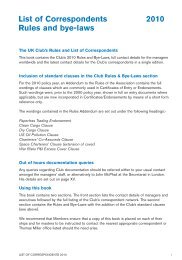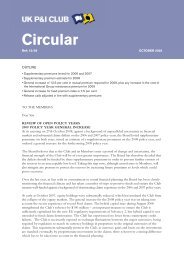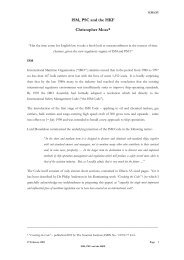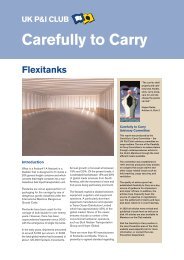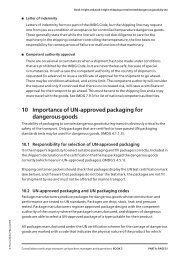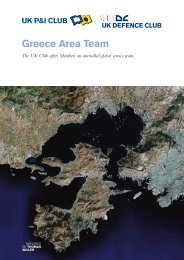Biofuels - UK P&I
Biofuels - UK P&I
Biofuels - UK P&I
You also want an ePaper? Increase the reach of your titles
YUMPU automatically turns print PDFs into web optimized ePapers that Google loves.
FAME is denoted B100, standing for 100% ‘biodiesel’.<br />
Other common blends include B5 (5% ‘biodiesel’ and<br />
95% conventional diesel), B7 (the EN590 European<br />
diesel standard allows up to 7% by volume FAME in<br />
diesel) and B20 (20% ‘biodiesel’ and 80%<br />
conventional diesel). In the <strong>UK</strong>, a major supermarket<br />
chain has introduced B30 (30% ‘biodiesel’ and 70%<br />
conventional diesel) pumps onto a number of their<br />
forecourts (Motor Consult Update November 2008).<br />
However, this fuel is not currently governed by any<br />
standards and is not approved for use by many of the<br />
major automobile manufacturers.<br />
Raw materials for FAME production<br />
A wide number of raw materials can be used for the<br />
production of FAME, including palm oil, coconut oil,<br />
rapeseed oil, soybean oil, tallow and used cooking oils.<br />
A general FAME cargo might be the product of<br />
processing any one of these raw materials, or may<br />
indeed be a mixture of FAMEs produced from different<br />
raw materials. Each raw material would give FAME of a<br />
different chemical composition, with correspondingly<br />
different characteristics. For example, if we compare a<br />
FAME derived from palm oil (PME) with a FAME derived<br />
from rapeseed oil (RME), it is possible to notice an<br />
immediate visible difference between the two – namely<br />
that at normal <strong>UK</strong> winter temperatures the PME is likely<br />
to be solidified whereas the RME will be a liquid. It is<br />
the chemical composition of the raw materials and the<br />
FAMEs produced from them that explains many of the<br />
different characteristics displayed.<br />
One of the most important chemical characteristics of<br />
FAME is the structure and composition of the fatty acid<br />
methyl ester groups, which will be determined by the<br />
fatty acid components of the raw material used in the<br />
production process. Pictorially, we can see a<br />
difference if we look at the structures of two different<br />
fatty acids below – one a saturated fatty acid and one<br />
an unsaturated fatty acid – the saturated fatty acid has<br />
a ‘straight chain’ of carbon atoms (circled in red)<br />
whereas the unsaturated fatty acid has, in this case,<br />
two ‘double bonds’ present in the hydrocarbon chain.<br />
These are circled in green and result in ‘kinks’ in the<br />
hydrocarbon chain:<br />
Myristic Acid – A saturated fatty acid<br />
Linoleic Acid – An unsaturated fatty acid<br />
FAME species which are composed of a relatively high<br />
proportion of saturated fatty acid methyl esters, for<br />
example, palm oil derived FAME (denoted PME) will in<br />
general be relatively stable to unwanted degradation<br />
reactions, but will have poorer cold temperature<br />
performance. FAME species which are composed of a<br />
relatively high proportion of unsaturated fatty acid<br />
methyl esters, for example, soybean oil derived FAME<br />
(denoted SME), will display markedly different<br />
behaviour, typically having improved cold temperature<br />
properties in comparison to PME, but being less stable<br />
to degradation reactions. The reason for the improved<br />
cold-temperature behaviour displayed by the FAME<br />
species high in unsaturated fatty acid methyl esters is<br />
that for every double bond in the hydrocarbon chain<br />
and associated kink in the molecule, the individual<br />
molecules cannot pack as closely together thereby<br />
reducing intermolecular forces and correspondingly<br />
decreasing the melting point. However, it is the<br />
presence of the double bonds in the unsaturated FAME<br />
species that infers the greater degree of instability<br />
upon the molecules – the double bond sites render the<br />
molecule prone to oxidative degradation.<br />
The presence and composition of other chemical<br />
constituents are also important. For example, FAMEs<br />
with high levels of vitamin E are thought to be more<br />
stable to unwanted oxidative degradation reactions.<br />
Recent research reported in Biodiesel magazine has<br />
identified the formation of sediments in stored B5 and<br />
B20 blends. Analysis of the sediment components<br />
suggests that they originate from the oxidation of<br />
unsaturated fatty acid methyl ester components of<br />
FAME. However, the addition of antioxidants to the<br />
neat FAME prior to blending was found to prevent<br />
sediment formation. Vitamin E is a natural antioxidant<br />
which would appear to prevent the occurrence of such<br />
unwanted oxidation reactions.<br />
FAME problems<br />
Water contamination: A major problem with regard<br />
to the carriage of FAME by sea is the issue of water<br />
contamination. FAME is a hygroscopic material, which<br />
means that is will absorb water from its surrounding<br />
environment, including the atmosphere. This renders




